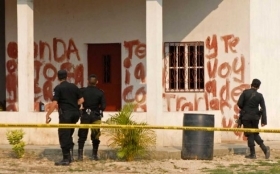Guatemala declared a state of siege in the northern department of Peten as details began to emerge of the massacre of 27 farm laborers, believed to have been murdered by the Mexican drug gang the Zetas.
President Alvaro Colom was at pains to show a strong government response to the massacre, which he called sadistic and perverse. He traveled to the site of the kilings, and was photographed inspecting the blood-stained scene of the crime.
The president then declared a state of siege, which puts the army in control of the department for 30 days, allowing them to arrest people and search houses without a warrant, as well as to break up public gatherings. The same measures were imposed on the neighboring department of Alta Verapaz in December last year in an effort to contain spiralling crime, including violence from the Zetas.
As details of the killing have been released, some theories as the motives behind them have emerged. The government said that the victims were not linked to the drug trade; it seems that they were hacked to pieces to send a message to the farm’s owner, identified by authorities as Rudy Ottoniel Salguero Morales.
According to survivors, 30 or 40 armed men came to the farm on Saturday night and asked for the owner. When they could not find him, they tied up some farm workers and began the slaughter, decapitating many of their victims. One was only 13 years old. The killers left a message scrawled in blood on the walls, which said that they were looking for Salguero.
Unlike his unlucky employees, Salguero may have been involved in the drug business. Colom said that government forces are currently investigating the farm owner’s alleged links with organized crime. Prensa Libre reported that these investigations suggest Salugero was working with a local group, the Mendozas, and that his job was to transport drug shipments to Mexico. The same report said that the farm owner might have stolen a drug shipment from the Zetas. If this is the case then the Zetas were clearly stating that anyone who steals from them can expect only the most brutal retribution.
If this is true, it would undermine the theory suggested yesterday by commentators (including InSight) that the massacre was part of a push by the Zetas against local gang the Leones. This speculation was based on the killing only one day previously of Haroldo Waldemar Leon, a leader of the group, also in Peten.
The Mendozas are erstwhile contacts of the Zetas, who have reportedly hired them to carry out assassinations against the Leones. This move had unwanted consequences when the Zetas decided to remain in northern Guatemala, tightening their hold on the drug trade and buying up, or seizing, properties to gain wider territorial control.
Salguero is nowhere to be found. It seems that he knew the Zetas were looking for him — families of some of the victims told the press that their relatives had said they did not want to keep working at the farm, because two weeks previously armed men had come, asking for Salguero.
Salguero’s niece was reportedly kidnapped days before the killing, along with her husband and his father. Her dismembered body was found on Friday.
The branch of the Zetas thought to have carried out the killings is known as “Zeta 200” after its former commander, Flavio·Mendez Santiago, also known as “El Amarillo.” Mendez, who reportedly controlled the Zetas’ operations in Guatemala, was captured in Mexico in January, but his unit in the country remains strong.
Guatemalan police announced the arrest of one suspect on Tuesday, after a gunfight in which two alleged Zetas members were killed. The detainee has been identified as Hugo Francisco Chavez Mendez, who reportedly worked as an air traffic controller for the the Civil Aeronautics Division in Peten. This may indicate the Zetas’ reach, with an ability to corrupt professionals in various walks of life.
The state of siege could have some impact on reducing crime in the short term, as one of the things that draws armed groups like the Zetas to Peten is its lawlessness. The jungle-covered department, which shares hundreds of miles of border with Mexico, is a huge and lawless area which covers around a third of Guatemala’s land mass, but has only around three percent of its population. There is little government control; the BBC reported last year that there were only 250 soldiers patrolling 5,000 square kilometers of the region. A temporary influx of troops could therefore deter illegal groups, but would be unlikely to permanently disrupt their operations.
The declaration is not just a knee-jerk move from the government. Peten’s governor has called on the president to impose a state of siege, complaining in February that the region was overrun by drug traffickers. Colom had said that the government did not have the resources to make this happen, but it seems that the weekend’s gruesome events have changed his mind.

